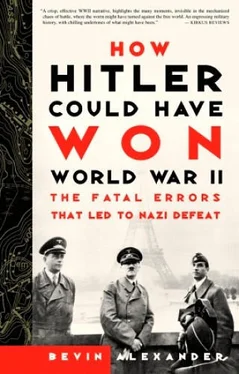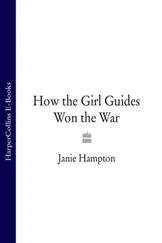Ammunition supplies dropped, fuel became scarce, and the men of 6th Army began to starve.
Meanwhile the Soviet army group Voronezh Front under F. I. Golikov on the north opposite the Italian 8th Army prepared for another—even more dangerous—enveloping movement. Hitler, ignoring the threat, handed Manstein the task of relieving 6th Army.
15 MANSTEIN SAVES THE ARMY

WITH STALINGRAD SURROUNDED, AND TWO ROMANIAN ARMIES VIRTUALLY EXTINGUISHED, it was apparent to senior officers on both sides that a war-winning victory lay within reach of the Russians.
Only 150 miles separated Rostov and a flimsy new defensive line Manstein formed along the Chir River, a hundred miles west of Stalingrad. Yet the left wing of Army Group A lay deep in the Caucasus 375 miles from Rostov, while 4th Panzer Army, south of Stalingrad, was 250 miles from Rostov.
If the Russians could crash through to Rostov, they could cut off the remainder of Army Group B, the scratch forces Manstein was throwing together in his new Army Group Don, and the two armies of Army Group A in the Caucasus—in other words, all German forces on the southern wing.
If the southern German flank were eliminated, the remaining German forces in the east would be too weak to fend off the Red Army, and Germany would lose the war in months, if not weeks.
The Red Army was planning to unleash this strategic thunderbolt and had selected a vulnerable point of attack: the Italian 8th Army on the Don just northwest of the Chir.
Manstein formed an emergency defense line with communications zone troops in Hoth’s 4th Panzer Army around Kotelnikovo, eighty miles southwest of Stalingrad, closing a void where the Romanian 4th Army had vanished.
Although worried about a Russian strike for Rostov, Manstein’s foremost task was to liberate 6th Army. Unless this army was freed, there was no hope of restoring the situation on the southern wing. If the army remained at Stalingrad, it would die. Any relief operation had to break open a path for 6th Army to come out, not to reestablish a supply line to it. Surely, Manstein told himself, Hitler would see the light when the time came and allow the army to withdraw.
There were two possible escape routes. The closest was straight west to Kalach. Here, however, the Russians were massed and would contest every inch. There was a slightly better chance to break through around Kotelnikovo and drive northeast toward Stalingrad.
Once a relief operation started from Kotelnikovo, pressure on 6th Army would ease, because the Red Army would have to challenge the relief forces. When this happened, Manstein reasoned, German elements on the Chir could strike toward Kalach, smash into the rear of the Soviet siege ring there, and facilitate 6th Army’s breakout.
But time was of the essence. Army chief of staff Zeitzler agreed to send 57th Panzer Corps under Friedrich Kirchner (23rd and 6th Panzer Divisions, and 15th Luftwaffe Field Division) to 4th Panzer Army to spearhead the relief drive from Kotelnikovo, and eight divisions in a new Army Detachment Hollidt (General Karl Adolf Hollidt) to advance from the upper Chir. These forces were to arrive in the first days of December.
They might be enough, if they came in time, to cut a corridor to 6th Army, replenish it with fuel, ammunition, and food, restore its freedom of movement, and get it out. Manstein so informed the Fuehrer on November 28.
“I told Hitler,” Manstein wrote later, “it was strategically impossible to go on tying down our forces in an excessively small area while the enemy enjoyed a free hand along hundreds of miles of front.”
It was December 3 before Hitler even replied, and he refused to allow 6th Army to switch troops from its northern flank to the southwest to prepare for the relief force. Manstein did not realize that Hitler had not the slightest intention of evacuating 6th Army from Stalingrad.
Most of the reinforcements did not arrive on time. Of the eight divisions for Army Group Hollidt, three didn’t appear at all, one of the panzer divisions was so shot up as to be useless, and one Luftwaffe Field Division arrived too late. All that came in time for Hollidt was the 48th Panzer Corps under Otto von Knobelsdorff with the 11th Panzer and the 336th Infantry Division, and a Luftwaffe Field Division. For Hoth, only the 57th Panzer Corps arrived.
With so few troops, Manstein gave up the idea of relieving 6th Army from two directions. Everything now depended upon a direct strike (code-named Winter Tempest) by 4th Panzer Army from Kotelnikovo.
Because of delays in the arrival of 57th Panzer Corps, Manstein had to postpone the strike to December 12. Meantime, a dangerous threat appeared on the Chir front. On December 7, the Russian 1st Armored Corps forced its way over the river near Surovikino, twenty miles upstream (northwest) from the Chir’s junction with the Don at Nizhna Chirskaya. The Russians swept toward State Farm 79 fifteen miles in the rear. General Knobelsdorff had lined his 336th Infantry Division along the river on the right or east, and the Luftwaffe Field Division on the left.
The situation was grim. A Soviet breakthrough on the Chir would unhinge the drive toward Stalingrad, clear the way to the Morosovsky and Tatsinskaya airfields only twenty-five and fifty miles away, from which supplies were being flown to Stalingrad, and open a path to crossings of the Donetz River and Rostov.
Hermann Balck’s 11th Panzer Division checked the Russian advance at the state farm. While his antiaircraft guns and his engineers formed up below the farm to prevent the Russians moving south, one panzer grenadier (motorized infantry) regiment delivered an attack on the farm from the southwest at dawn on December 8. Once the Russians were locked in this engagement, Balck’s panzer regiment and his second panzer grenadier regiment thrust into the rear of the Russians from a low ridge northwest of the farm.
This rear attack caught the Russians just as they were about to advance northward against the rear of 336th Division. Truck after truck loaded with infantry went up in flames as the panzers charged through the column. The tanks destroyed this force, then turned into the rear of the Russian armor at the state farm, knocking out fifty-three tanks and sending the remainder fleeing.
Over the next four days, Balck’s panzer division, using the 336th Division as a pivot, turned back two simultaneous assaults by the Russian 5th Tank Army, one half a dozen miles northwest of Nizhna Chirskaya, the other fifteen miles upstream. On December 17 and 18 two new violent attacks broke across the Chir. The 11th Panzer drove one back to a narrow foothold, then turned on the other. The division had only twenty-five tanks left, but got on the rear of the advancing Russian armor and destroyed sixty-five enemy tanks before the Russians woke up to what was happening. The remaining Russians fled. Over the next few days, new Russian attacks convulsed the Chir front, but 11th Panzer, acting like a fire brigade, broke the back of one breakthrough after another, and by December 22 the Soviets had given up.
Part of the reason for the German success was the expertise and discipline of the panzer troops. Part was due to the Russian tank crews, who had scarcely any training. Likewise, the Russian commander sent in tank corps (groups of brigades about the size of divisions) without coordinating times of attacks, permitting Balck’s panzers to deal with one crisis at a time.
While these fights were going on, Manstein launched Operation Winter Tempest, using only 57th Panzer Corps. His attack surprised the enemy, and made good progress, although the Russians brought up troops from around Stalingrad and counterattacked again and again.
Читать дальше



![Джонатан Димблби - Barbarossa - How Hitler Lost the War [calibre]](/books/385421/dzhonatan-dimblbi-barbarossa-how-hitler-lost-the-w-thumb.webp)









